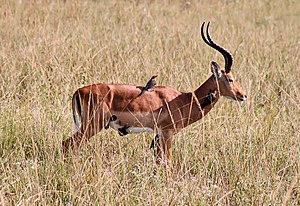Portal:Tanzania
 The Tanzania Portal
Tanzania, officially the United Republic of Tanzania, is a country in East Africa within the African Great Lakes region. It is bordered by Uganda to the north; Kenya to the northeast; the Indian Ocean to the east; Mozambique and Malawi to the south; Zambia to the southwest; and Rwanda, Burundi, and the Democratic Republic of the Congo to the west. Mount Kilimanjaro, Africa's highest mountain, is in northeastern Tanzania. According to the 2022 national census, Tanzania has a population of nearly 62 million, making it the most populous country located entirely south of the equator. Many important hominid fossils have been found in Tanzania, such as 6-million-year-old Pliocene hominid fossils. In the Stone and Bronze Age, prehistoric migrations into Tanzania included Southern Cushitic speakers who moved south from present-day Ethiopia; Eastern Cushitic people who moved into Tanzania from north of Lake Turkana about 2,000 and 4,000 years ago; and the Southern Nilotes, including the Datoog, who originated from the present-day South Sudan–Ethiopia border region between 2,900 and 2,400 years ago. These movements took place at about the same time as the settlement of the Mashariki Bantu from West Africa in the Lake Victoria and Lake Tanganyika areas. In the late 19th century, the mainland came under German rule as German East Africa, and this was followed by British rule after World War I when it was governed as Tanganyika, with the Zanzibar Archipelago remaining a separate colonial jurisdiction. Following their respective independence in 1961 and 1963, the two entities merged in 1964 to form the United Republic of Tanzania. Tanganyika joined the British Commonwealth and Tanzania remains a member of the Commonwealth as a unified republic. Tanzania is mountainous and densely forested in the north-east, where Mount Kilimanjaro, the highest mountain in Africa and the highest single free-standing mountain above sea level in the world, is located. Three of Africa's Great Lakes are partly within Tanzania. To the north and west lie Lake Victoria, Africa's largest lake, and Lake Tanganyika, the continent's deepest lake, known for its unique species of fish. To the south lies Lake Malawi. The eastern shore is hot and humid, with the Zanzibar Archipelago just offshore. The Menai Bay Conservation Area is Zanzibar's largest marine protected area. The Kalambo Falls, located on the Kalambo River at the Zambian border, is the second-highest uninterrupted waterfall in Africa. Tanzania is one of the most visited tourist destinations for safaris. Selected article -
The United Kingdom made a number of plans to intervene in response to the Zanzibar Revolution. The operational constraints of sending troops over such long distances, the reluctance of the Kenyan government to weaken the British presence in their country, the reduction of Western presence in Zanzibar, and the strengthening of the political situation in Tanzania made intervention unlikely, and the plans were suspended in October 1964. A newly elected Labour government cancelled the final plan in December of that year. (Full article...)
General images -The following are images from various Tanzania-related articles on Wikipedia.
This month in Tanzanian history
Wildlife of Tanzania - Credit: Muhammad Mahdi Karim
An impala (Aepyceros melampus Greek αιπος, aipos "high" κερος, ceros "horn" + melas "black" pous "foot") is a medium-sized African antelope. The name impala comes from the Zulu language meaning "Gazelle". They are found in savannas and thick bushveld in Kenya, Tanzania, Eswatini, Mozambique, northern Namibia, Botswana, Zambia, Zimbabwe, southern Angola, northeastern South Africa and Uganda. Did you know ...
CategoriesWikiProjectsRecognised contentSelected panorama -Skyline of the Dar es Salaam city center.
Uganda–Tanzania War -Articles here focus upon aspects of the Uganda–Tanzania War. These are all Good articles that meet a core set of high editorial standards.
The Battle of Tororo was a battle of the Uganda–Tanzania War that took place from 2 to 4 March 1979 at Tororo, Uganda and its surroundings. It was fought between Ugandan rebels loyal to Milton Obote and Uganda Army units loyal to President Idi Amin. In an attempt to destabilise Amin's rule and capture weapons for an insurrection, a group of guerrillas launched a raid from Kenya against Tororo, whose garrison partially mutinied and joined them after a brief fight. Loyalist Ugandan military forces, most importantly its air force, launched a large-scale counter-attack and defeated the rebels after heavy fighting. (Full article...) TopicsSelected picture -Related portalsThings you can doAssociated WikimediaThe following Wikimedia Foundation sister projects provide more on this subject:
Discover Wikipedia using portals | ||||










































































